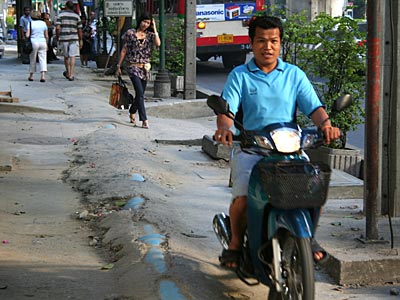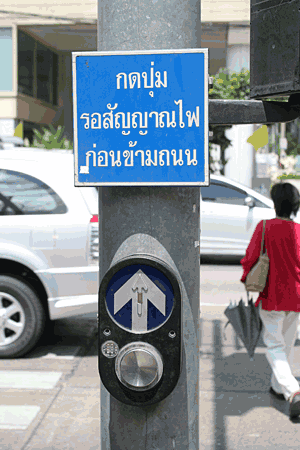10 Wishes - Please Protect the Pedestrians
See video of how to cross a busy road in Bangkok (bottom of this page).
We don not use a personal car and often walk around Bangkok, crossing various streets and intersections where traffic is not regulated by traffic lights.
When traffic police is present, it is astounding how they often neglect to observe the crowd of pedestrians wanting to cross the road. They only have eyes for the cars (and the motorcycles) and want to keep the car traffic float along.
Pedestrians are left on their own, and cross the street at their own risk. Often just numbers will do. If a small crowd has gathered it takes usually one daredevil to walk onto the road and all will follow, and 'force' cars to stop. Cars seem also to be more willing to stop for females, so one can also use this tactic and hide behind them when they start moving.
When traffic police is not there, another major problem ensues. Zebra crossings are blatantly neglected by most cars and motorcycles, and seem rather to spur them on to increase their speed. Most cars in Bangkok have tinted glass windows, making it also impossible to make eye contact with the drivers.
Over the years, I have often heard remarks that Thai people are not really friendly at all (as universally and locally acclaimed, since Thailand is the Land of Smiles). This is supposed to be proven by their selfish unconsiderate behaviour on the roads, and their neglect and endangerment of fellow road users (pedestrians).
[Personally, we would not go as far as that. What shows through in the behaviour on the road, is that Thai people are friendly depending on the social circumstances. When under social control, like face-to-face interaction, the result is amiable communication and interaction, making for a pleasant daily life environment. One could say friendliness is often (not always though) only skin-deep, and less of an internal value, than a socially-imposed behaviour.]

State of the pedestrian walkway between Asoke Road and Emporium Shopping Complex a while back. It stayed this way for many months, before road works were completed. Motorcycles on the pavement (even police) were a common sight.
Bangkok's Sidewalks : Pedestrians, Wheelchairs, Strollers
Bangkok's sidewalks are not exactly pleasant to walk on. The pavement will almost be invariable damaged, with potholes and loose tiles. The pavement is regularly replaced. There is a special unit of the Bangkok municipality arranging new pavements around the city, we think like every 3-5 years. The pavement is tiled, but not much underground support is provided, since digging along the road needs to be easy, in view of the frequent necessity to dig holes and updating water utilities and the like. As a result, the pavement often starts deteriorating a few months after its 'renovation'. Tiles come loose, water seeps in, the underground subsides etc.
The pavement in Thailand is elevated above road level. This makes it just a little bit easier to walk during or after flooding of the roads. If they were not elevated, cars would also use the sidewalk for traffic and for parking. While the sidewalk is elevated, it is often intersected by access roads to houses, shopping centers, and other buildings. So one has to continuously step off and on the pavement. This likely is not beneficial for your knee joints and hips, and you may misstep and twist your ankles.[Note : there is a theory that says walking or running on uneven surfaces is good for the brain, since it asks for contiunous adaptation to the environment. That said, there is likely an age or a state of disability, were uneven sidewalks become to hazardous]
While walking in general is a bit of an obstacle course, it becomes truely difficult for wheelchair users and strollers. We have personal experience with pushing a friend in his wheelchair around town, and know first hand how difficult it can get. One has to continuously push the wheelchair off the pavement and pull it on again. Ramps are usually not present, and if they are they sometimes are a sign for motorcycles to use the sidewalk. Often, the only solution for moving along, is to push a wheelchair on the side of the road, with all hazards involved.
Very few Thai people actually use strollers. Besides the expense, they seem to prefer to carry their children, women often positioning them on their hips. Foreign visitors can often be seen pushing strollers along, with the child rocking in its chair, each time the stroller moves off and up the sidewalk. This must each time (if the parent is not really careful) present a minor brain jolting for the little ones. Who knows, that is how one gets Parkinson's disease or Alzheimer's in later life?
Provisions for wheelchairs are still lacking in Bangkok. Even the skytrain (BTS) and the subway (MRT) are hardly equipped. Both have elevators for that purpose, but we do not see them used at all, and we estimate it will take about 15 minutes before transport can be arranged that way. As for the skytrain, some stations still have few or no escalators installed, making negotiating three or even six flights of stairs too difficult for elderly people, and for those with a heart or lung condition.

There are at least 3 zebra crossings on Asoke road, supported by a push-button, that makes the traffic lights for passing cars go to red (after 150 seconds !), thus allowing pedestrians to cross the road. In true Thai fashion, a woman is crossing the road here, without using it. And what is worse, cars and certainly motorcycles quite blatantly neglect the red lights. A young woman was killed a few years ago while using a zebra crossing on Asoke road.
More Hazards for Pedestrians
There are at least two more hazards for pedestrians. The situation with the first is improving, while the second hazard is difficult to get rid off.
A few years ago (we recall this did not happen let's say a decade ago), some motorcycles started using the sidewalks. This was sometimes made easier because ramps, intended for strollers and wheelchairs to get up the pavement, were constructed. Eventually heavy penalties were announced (up to 5,000 Thai baht), and some stricter implementation of the relevant laws. As a result, the situation has improved somewhat lately.
A second problem are obstacles on the road. There is the situation of the abundance of vendors, trying to make a living. Up to 2020 there was hardly any unemployment reported in economic statistics. We used to think that everybody without a regular job, just started cooking food and selling trinkets, on the sidewalks. Some rules have been implemented the last few years though. As a result, some parts of Silom road and Sukhumvit road are free of vendors during the daytime hours, and they are only allowed in the evening hours. Nevertheless, it often is necessary for pedestrians to get off the sidewalk, and onto the road, because traffic on the sidewalk is too slow because of overcrowding with vendors and buyers (of food).

Mirror (in front of a 7-Eleven) to make it easier for approaching cars to see whether there is traffic coming from left or right. Placed too low for regular sized males. Dangerous because quite a few people will walk in front of the concrete pole, before walking into the 7-Eleven.
Another hazard for pedestrians are signs installed on the pavement. The main culprits here are signs indicating on which day to park where (left or right side of the road). They are especially dangerous when for some reason placed parellel to the walking direction, making them difficult to be noticed, certainly for those wearing a hat. Lots of signs are placed with a lower height of around 160 cm, probably adapted to the time when Thai people were much smaller than nowadays. If the edges of the traffic signs are old and rusty, you can have additional damage besides a minor concussion.

